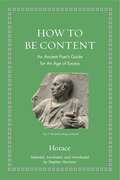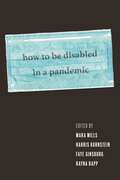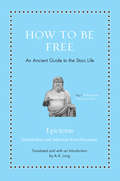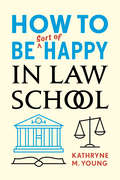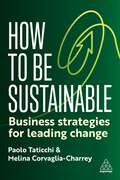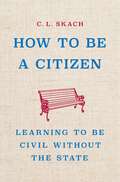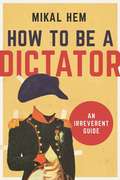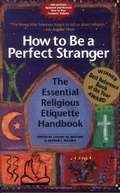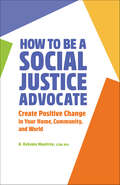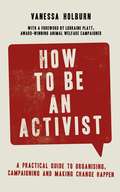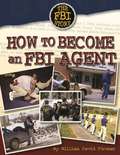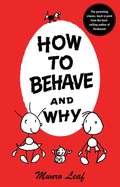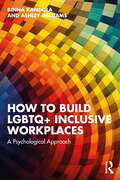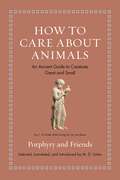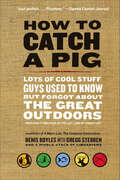- Table View
- List View
How to Be Content: An Ancient Poet's Guide for an Age of Excess (Ancient Wisdom for Modern Readers)
by Horace Stephen HarrisonWhat the Roman poet Horace can teach us about how to live a life of contentment What are the secrets to a contented life? One of Rome’s greatest and most influential poets, Horace (65–8 BCE) has been cherished by readers for more than two thousand years not only for his wit, style, and reflections on Roman society, but also for his wisdom about how to live a good life—above all else, a life of contentment in a world of materialistic excess and personal pressures. In How to Be Content, Stephen Harrison, a leading authority on the poet, provides fresh, contemporary translations of poems from across Horace’s works that continue to offer important lessons about the good life, friendship, love, and death.Living during the reign of Rome’s first emperor, Horace drew on Greek and Roman philosophy, especially Stoicism and Epicureanism, to write poems that reflect on how to live a thoughtful and moderate life amid mindless overconsumption, how to achieve and maintain true love and friendship, and how to face disaster and death with patience and courage. From memorable counsel on the pointlessness of worrying about the future to valuable advice about living in the moment, these poems, by the man who famously advised us to carpe diem, or “harvest the day,” continue to provide brilliant meditations on perennial human problems.Featuring translations of, and commentary on, complete poems from Horace’s Odes, Satires, Epistles, and Epodes, accompanied by the original Latin, How to Be Content is both an ideal introduction to Horace and a compelling book of timeless wisdom.
How to Be Disabled in a Pandemic
by Mara Mills, et al.,A chronicle of ableism and disability activism in New York City during the COVID-19 pandemicHow to Be Disabled in a Pandemic documents the pivotal experiences of disabled people living in an early epicenter of COVID-19: New York City. Among those hardest hit by the pandemic, disability communities across the five boroughs have been disproportionately impacted by city and national policies, work and housing conditions, stigma, racism, and violence—as much as by the virus itself. Disabled and chronically-ill activists have protested plans for medical rationing and refuted the eugenic logic of mainstream politicians and journalists who “reassure” audiences that only older people and those with disabilities continue to die from COVID-19. At the same time, as exemplified by the viral hashtag #DisabledPeopleToldYou, disability expertise has become widely recognized in practices such as accessible remote work and education, quarantine, and distributed networks of support and mutual aid. This edited volume charts the legacies of this “mass disabling event” for uncertain viral futures, exploring the dialectic between disproportionate risk and the creativity of a disability justice response.How to Be Disabled in a Pandemic includes contributions by wide-ranging disability scholars, writers, and activists whose research and lived experiences chronicle the pandemic’s impacts in prisons, migrant detention centers, Chinatown senior centers, hospitals in Queens and the Bronx, subways, schools, housing shelters, social media, and other locations of public and private life. By focusing on New York City over the course of three years, the book reveals key themes of the pandemic, including hierarchies of disability "vulnerability," the deployment of disability as a tool of population management, and innovative crip pandemic cultural production. How to Be Disabled in a Pandemic honors those lost, as well as those who survived, by calling for just policies and caring infrastructures, not only in times of crisis but for the long haul.
How to Be Free: An Ancient Guide to the Stoic Life (Ancient Wisdom for Modern Readers)
by Epictetus Anthony LongA superb new edition of Epictetus’s famed handbook on Stoicism—translated by one of the world’s leading authorities on Stoic philosophyBorn a slave, the Roman Stoic philosopher Epictetus (c. 55–135 AD) taught that mental freedom is supreme, since it can liberate one anywhere, even in a prison. In How to Be Free, A. A. Long—one of the world’s leading authorities on Stoicism and a pioneer in its remarkable contemporary revival—provides a superb new edition of Epictetus’s celebrated guide to the Stoic philosophy of life (the Encheiridion) along with a selection of related reflections in his Discourses.Freedom, for Epictetus, is not a human right or a political prerogative but a psychological and ethical achievement, a gift that we alone can bestow on ourselves. We can all be free, but only if we learn to assign paramount value to what we can control (our motivations and reactions), treat what we cannot control with equanimity, and view our circumstances as opportunities to do well and be well, no matter what happens to us through misfortune or the actions of other people.How to Be Free features splendid new translations and the original Greek on facing pages, a compelling introduction that sets Epictetus in context and describes the importance of Stoic freedom today, and an invaluable glossary of key words and concepts. The result is an unmatched introduction to this powerful method of managing emotions and handling life’s situations, from the most ordinary to the most demanding.
How to Be Sort of Happy in Law School
by Kathryne M. YoungEach year, over 40,000 new students enter America's law schools. Each new crop experiences startlingly high rates of depression, anxiety, fatigue, and dissatisfaction. Kathryne M. Young was one of those disgruntled law students. After finishing law school (and a PhD), she set out to learn more about the law school experience and how to improve it for future students. Young conducted one of the most ambitious studies of law students ever undertaken, charting the experiences of over 1000 law students from over 100 different law schools, along with hundreds of alumni, dropouts, law professors, and more. How to Be Sort of Happy in Law School is smart, compelling, and highly readable. Combining her own observations and experiences with the results of her study and the latest sociological research on law schools, Young offers a very different take from previous books about law school survival. Instead of assuming her readers should all aspire to law-review-and-big-firm notions of success, Young teaches students how to approach law school on their own terms: how to tune out the drumbeat of oppressive expectations and conventional wisdom to create a new breed of law school experience altogether. Young provides readers with practical tools for finding focus, happiness, and a sense of purpose while facing the seemingly endless onslaught of problems law school presents daily. This book is an indispensable companion for today's law students, prospective law students, and anyone who cares about making law students' lives better. Bursting with warmth, realism, and a touch of firebrand wit, How to Be Sort of Happy in Law School equips law students with much-needed wisdom for thriving during those three crucial years.
How to Be Sustainable: Business Strategies for Leading Change
by Paolo Taticchi Melina Corvaglia-CharreyAmid the many challenges facing the world today - not least the climate crisis - the need for bold and steadfast leadership has never been greater. How to Be Sustainable uncovers the strategies that lead organizations to sustainable success. While over 90% of business leaders recognize the importance of sustainability, only 60% have a strategy in place. And many of these strategies are inefficient, ineffective, or simply don't go far enough to address the global challenges we are facing.Leading sustainability expert Paolo Taticchi and co-author Melina Corvaglia-Charrey have interviewed some of the world's leading Chief Sustainability Officers from various sectors and businesses including Enel Group, Microsoft, Canon, and Sage. Guided by expert insights and real-world examples of sustainable practices, this book explores the impact and significance of sustainability in business, offering practical strategies and tools that will allow you and your business to make a positive impact. Whether you're an experienced leader, an aspiring CSO, or passionate about sustainability, the insights shared in this book will empower and inspire you to shape a better world for future generations.
How to Be a Bad Emperor: An Ancient Guide to Truly Terrible Leaders (Ancient Wisdom for Modern Readers)
by SuetoniusWhat would Caligula do? What the worst Roman emperors can teach us about how not to leadIf recent history has taught us anything, it's that sometimes the best guide to leadership is the negative example. But that insight is hardly new. Nearly 2,000 years ago, Suetonius wrote Lives of the Caesars, perhaps the greatest negative leadership book of all time. He was ideally suited to write about terrible political leaders; after all, he was also the author of Famous Prostitutes and Words of Insult, both sadly lost. In How to Be a Bad Emperor, Josiah Osgood provides crisp new translations of Suetonius's briskly paced, darkly comic biographies of the Roman emperors Julius Caesar, Tiberius, Caligula, and Nero. Entertaining and shocking, the stories of these ancient anti-role models show how power inflames leaders' worst tendencies, causing almost incalculable damage.Complete with an introduction and the original Latin on facing pages, How to Be a Bad Emperor is both a gleeful romp through some of the nastiest bits of Roman history and a perceptive account of leadership gone monstrously awry. We meet Caesar, using his aunt's funeral to brag about his descent from gods and kings—and hiding his bald head with a comb-over and a laurel crown; Tiberius, neglecting public affairs in favor of wine, perverse sex, tortures, and executions; the insomniac sadist Caligula, flaunting his skill at cruel put-downs; and the matricide Nero, indulging his mania for public performance.In a world bristling with strongmen eager to cast themselves as the Caesars of our day, How to Be a Bad Emperor is a delightfully enlightening guide to the dangers of power without character.
How to Be a Citizen: Learning to Be Civil Without the State
by C. L. SkachAn expert on the writing of constitutions argues that the path to a thriving society begins with forgetting about them: "Not James Madison but Bob Dylan or Annie Lennox should be our guide" (Mark Tushnet). In 2009, constitutional scholar C. L. Skach went to Iraq to help revise the constitution. She survived a missile barrage in the Green Zone—an event that proved a breaking point in her thinking about constitutions. In short: they don&’t really work. In How to Be a Citizen, Skach calls to move beyond constitutions. She argues that just as complex natural systems spontaneously generate order, we can, too. Looking to pandemic gardens, Reggio-Emilia schools, and community-driven safety patrols, she envisions not government by force, but society that is local, cultivated, and true. Grounded in six principles as simple as a call to spend time on a park bench, this book shows how community spaces, education, and markets can be reshaped to nurture cooperation and encourage flourishing. Equal parts personal, philosophical, and practical, How to Be a Citizen invites us to see society not as something imposed by law, but rather something we create together.
How to Be a Dictator: An Irreverent Guide
by Mikal HemA Tongue-in-Cheek Guide to Becoming a Dictator, Based on the Outrageous, Scandalous, and Excessive Behavior of Dictators Past and Present Who hasn’t dreamed of one day ruling your own country? Along with great power comes unlimited influence, control, admiration, and often wealth. How to Be a Dictator will teach you the tricks of the trade-how to rise to the top and stay in power, and how to enjoy the fruits of your excellence.Featuring examples from the most successful leaders and regimes in the business, including Kim Jong Il, Robert Mugabe, Muammar Gaddafi, Nicolae Ceausescu, François "Papa Doc” Duvalier, and many others, this handy guide offers ten easy lessons on becoming and acting like a dictator from how to rig an election and create your own personality cult to the dos and don’ts of dictator fashion. Other topics include: how to become wealthy and spend your fortune, sleeping around, expressing your literary genius, and how to avoid being toppled, exiled, and or meeting any other dismal end. Combining black humor with political insights, How to Be a Dictator is peppered with horrifying and hilarious stories from some of the most eccentric modern world leaders.
How to Be a Friend: An Ancient Guide to True Friendship (Ancient Wisdom for Modern Readers)
by Marcus Tullius Cicero Philip FreemanA splendid new translation of one of the greatest books on friendship ever writtenIn a world where social media, online relationships, and relentless self-absorption threaten the very idea of deep and lasting friendships, the search for true friends is more important than ever. In this short book, which is one of the greatest ever written on the subject, the famous Roman politician and philosopher Cicero offers a compelling guide to finding, keeping, and appreciating friends. With wit and wisdom, Cicero shows us not only how to build friendships but also why they must be a key part of our lives. For, as Cicero says, life without friends is not worth living.Filled with timeless advice and insights, Cicero’s heartfelt and moving classic—written in 44 BC and originally titled De Amicitia—has inspired readers for more than two thousand years, from St. Augustine and Dante to Thomas Jefferson and John Adams. Presented here in a lively new translation with the original Latin on facing pages and an inviting introduction, How to Be a Friend explores how to choose the right friends, how to avoid the pitfalls of friendship, and how to live with friends in good times and bad. Cicero also praises what he sees as the deepest kind of friendship—one in which two people find in each other “another self” or a kindred soul.An honest and eloquent guide to finding and treasuring true friends, How to Be a Friend speaks as powerfully today as when it was first written.
How to Be a Leader: An Ancient Guide to Wise Leadership (Ancient Wisdom for Modern Readers)
by PlutarchTimeless advice on how to be a successful leader in any fieldThe ancient biographer and essayist Plutarch thought deeply about the leadership qualities of the eminent Greeks and Romans he profiled in his famous—and massive—Lives, including politicians and generals such as Pericles, Alexander the Great, Julius Caesar, and Mark Antony. Luckily for us, Plutarch distilled what he learned about wise leadership in a handful of essays, which are filled with essential lessons for experienced and aspiring leaders in any field today. In How to Be a Leader, Jeffrey Beneker presents the most important of these essays in lively new translations accompanied by an enlightening introduction, informative notes, and the original Greek on facing pages.In "To an Uneducated Leader," "How to Be a Good Leader," and "Should an Old Man Engage in Politics?" Plutarch explains the characteristics of successful leaders, from being guided by reason and exercising self-control to being free from envy and the love of power, illustrating his points with memorable examples drawn from legendary Greco-Roman lives. He also explains how to train for leadership, persuade and deal with colleagues, manage one's career, and much more.Writing at the height of the Roman Empire, Plutarch suggested that people should pursue positions of leadership only if they are motivated by "judgment and reason"—not "rashly inspired by the vain pursuit of glory, a sense of rivalry, or a lack of other meaningful activities." His wise counsel remains as relevant as ever.
How to Be a Perfect Stranger: The Essential Religious Etiquette Handbook (4th edition)
by Arthur J. Magida Stuart M. MatlinsA straightforward guide to the rituals and celebrations of the major religions and denominations in the United States and Canada from the perspective of an interested guest of any other faith, this easy-to-use book is based on information obtained from authorities of each religion.
How to Be a Social Justice Advocate: Create Positive Change in Your Home, Community, and World
by A. Rahema MooltreyTake action to promote social justice with help from this practical guideSocial justice is about uplifting and empowering underserved and marginalized communities impacted by systems of oppression. While believing in equity and fairness is easy, taking action and doing your part requires work. This book is filled with practical, real-world advice that shows you how to serve and support your community through activism. You'll discover concrete steps you can take in 4 key areas that determine well-being and livelihood for all groups of people: education, economic stability, health, and safety.This standout among social justice books encourages you to:Get involved—Examine your intentions and unconscious biases, take stock of your strengths and interests, and consider important historical contexts when involving yourself in social justice work.See justice in action—Read relatable stories about real-life social justice wins to help inspire your own activism.Engage with others—Social justice is only possible when in community with others. Find tips on involving friends, family, and other community members in respectful and sustainable ways.Promote social justice and help create meaningful change with How to Be a Social Justice Advocate.
How to Be an Activist: A practical guide to organising, campaigning and making change happen
by Vanessa HolburnFrom experienced campaigner Vanessa Holburn and with a foreword by award-winning animal welfare campaigner Lorraine Platt, this is the essential guide to activism. 'Essential reading for anyone looking to start a grassroots campaign - and useful bedtime reading for some of our political parties too' - Hannah Beckerman, GuardianHow To Be an Activist covers everything you need to know to create a successful social campaign and bring about positive change no matter what your cause. This practical, inspirational book covers topics ranging from identifying your central issue and setting meaningful milestones and goals, to learning how to use the media effectively and stay safe and within the law. It will help you with every step of your campaign, keeping you motivated through periods of self-doubt and staving off burnout as you celebrate milestones on the way to creating meaningful change in the world. With contributions from influential campaigners including Natasha Devon MBE.Fresh from waving banners in the pouring rain, journalist and campaigner Vanessa Holburn passes on the lessons she has learned so the reader can fast track their movement to success. This is the age of activism and everyone is invited to join the movement.
How to Be an Activist: A practical guide to organising, campaigning and making change happen
by Vanessa HolburnFrom experienced campaigner Vanessa Holburn and with a foreword by award-winning animal welfare campaigner Lorraine Platt, this is the essential guide to activism. 'Essential reading for anyone looking to start a grassroots campaign - and useful bedtime reading for some of our political parties too' - Hannah Beckerman, GuardianHow To Be an Activist covers everything you need to know to create a successful social campaign and bring about positive change no matter what your cause. This practical, inspirational book covers topics ranging from identifying your central issue and setting meaningful milestones and goals, to learning how to use the media effectively and stay safe and within the law. It will help you with every step of your campaign, keeping you motivated through periods of self-doubt and staving off burnout as you celebrate milestones on the way to creating meaningful change in the world. With contributions from influential campaigners including Natasha Devon MBE.Fresh from waving banners in the pouring rain, journalist and campaigner Vanessa Holburn passes on the lessons she has learned so the reader can fast track their movement to success. This is the age of activism and everyone is invited to join the movement.
How to Become an FBI Agent
by William David ThomasThe Federal Bureau of Investigation (FBI) is a national agency dedicated to investigation federal crimes. Founded as a small team of special agents on July 26, 1908, the Bureau was first charged with enforcing the growing body of federal laws covering the United States as a whole. Almost from the beginning of its 100-year history, the Bureau has been the subject of legend and controversy. It has also evolved into a vast and sophisticated national law-enforcement agency. Whether as a federal crime-fighting force or a source of investigative support of local and state police forces, the modern FBI strives to embody its ideals of fidelity, bravery, and integrity. In these pages, you will follow the process-from application through graduation-of becoming an FBI special agent. Learn about the online application, the forms, and interviews. Try some sample questions from written exams. Then move on to the classrooms and firing ranges at the FBI Academy in Quantico, Virginia. Follow the training process through the streets, pool halls, and courtrooms of Hogan's Alley, the most crime-ridden town in America. Finally, learn about graduation, relocation, and beginning work as an FBI special agent.
How to Behave and Why
by Munro LeafHave you ever uncovered a hidden treasure of a book while browsing in some forgotten corner of a bookstore? I happened across How to Behave and Why in this fashion. Initially I was delighted by its bold red-and-black cover design, so simple and yet so arresting, and its charming stick-figure illustrations. It wasn't until I had read the book that I discovered its most enchanting feature: This book doesn't teach the most recent or fashionable etiquette of the day; it encourages a spirit of cooperation among people and a humanity that applies to societies the world over. This lesson is classic and timeless. I hope How to Behave and Why enchants you as it enchants me.
How to Build LGBTQ+ Inclusive Workplaces: A Psychological Approach
by Binna Kandola Ashley WilliamsBringing together the latest research with practical insights from the authors’ professional experience, this important book provides a context for the conversations that are needed within organisations and offers practical guidance towards action that can be taken to improve the working life of LGBTQ+ employees.The book begins by asking how we got here. It outlines the development of stigma towards the LGBTQ+ community from both a historical and psychological perspective before going on to explore the ways in which societal attitudes manifest in the work environment. It then looks specifically at LGBTQ+ experiences in the workplace, covering discrimination and exclusion and their impact at both an individual and organisational level before taking an intersectional view of LGBTQ+ identity, and particularly how it interacts with race, disability and age. The book then provides clear and practical guidance on how to build an LGBTQ+ inclusive workplace, covering organisational policy and culture, leadership and allyship. Throughout, the authors use case studies to demonstrate how to implement policies across a range of regions and offer strategies to minimise homophobic and discriminatory attitudes.Taking a psychological approach to this important topic, the book is essential reading for all those looking to build and sustain welcoming and inclusive workplaces across all sectors. It will also be of interest to students in psychology, management and human resources studying workplace attitudes and culture.
How to Build a Billion Dollar App: Discover the Secrets of the Most Successful Entrepreneurs of Our Time
by George BerkowskiTHE ULTIMATE GUIDE TO BUILDING AN APP-BASED BUSINESS - NOW REVISED AND UPDATED FOR 2017'A must read for anyone who wants to start a mobile app business' Riccardo Zacconi, founder and CEO King Digital (maker of Candy Crush Saga) 'A fascinating deep dive into the world of billion-dollar apps. Essential reading for anyone trying to build the next must-have app' Michael Acton Smith, Founder and CEO, Mind Candy Apps have changed the way we communicate, shop, play, interact and travel and their phenomenal popularity has presented possibly the biggest business opportunity in history.In How to Build a Billion Dollar App, serial tech entrepreneur George Berkowski gives you exclusive access to the secrets behind the success of the select group of apps that have achieved billion-dollar success.Berkowski draws exclusively on the inside stories of the billion-dollar app club members, including Instagram, Whatsapp, Snapchat, Candy Crush and Uber to provide all the information you need to create your own spectacularly successful mobile business. He guides you through each step, from an idea scribbled on the back of an envelope, through to finding a cofounder, building a team, attracting (and keeping) millions of users, all the way through to juggling the pressures of being CEO of a billion-dollar company (and still staying ahead of the competition).If you've ever dreamed of quitting your nine to five job to launch your own company, you're a gifted developer, seasoned entrepreneur or just intrigued by mobile technology, How to Build a Billion Dollar App will show you what it really takes to create your own billion-dollar, mobile business.
How to Build a Billion Dollar App: Discover the secrets of the most successful entrepreneurs of our time
by George BerkowskiTHE ULTIMATE GUIDE TO BUILDING AN APP-BASED BUSINESS 'A must read for anyone who wants to start a mobile app business' Riccardo Zacconi, founder and CEO King Digital (maker of Candy Crush Saga) 'A fascinating deep dive into the world of billion-dollar apps. Essential reading for anyone trying to build the next must-have app' Michael Acton Smith, Founder and CEO, Mind Candy Apps have changed the way we communicate, shop, play, interact and travel and their phenomenal popularity has presented possibly the biggest business opportunity in history.In How to Build a Billion Dollar App, serial tech entrepreneur George Berkowski gives you exclusive access to the secrets behind the success of the select group of apps that have achieved billion-dollar success.Berkowski draws exclusively on the inside stories of the billion-dollar app club members, including Instagram, Whatsapp, Snapchat, Candy Crush and Uber to provide all the information you need to create your own spectacularly successful mobile business. He guides you through each step, from an idea scribbled on the back of an envelope, through to finding a cofounder, building a team, attracting (and keeping) millions of users, all the way through to juggling the pressures of being CEO of a billion-dollar company (and still staying ahead of the competition).If you've ever dreamed of quitting your nine to five job to launch your own company, you're a gifted developer, seasoned entrepreneur or just intrigued by mobile technology, How to Build a Billion Dollar App will show you what it really takes to create your own billion-dollar, mobile business.
How to Build a Billion Dollar App: Discover the secrets of the most successful entrepreneurs of our time
by George BerkowskiTHE ULTIMATE GUIDE TO BUILDING AN APP-BASED BUSINESS 'A must read for anyone who wants to start a mobile app business' Riccardo Zacconi, founder and CEO King Digital (maker of Candy Crush Saga) 'A fascinating deep dive into the world of billion-dollar apps. Essential reading for anyone trying to build the next must-have app' Michael Acton Smith, Founder and CEO, Mind Candy Apps have changed the way we communicate, shop, play, interact and travel and their phenomenal popularity has presented possibly the biggest business opportunity in history.In How to Build a Billion Dollar App, serial tech entrepreneur George Berkowski gives you exclusive access to the secrets behind the success of the select group of apps that have achieved billion-dollar success.Berkowski draws exclusively on the inside stories of the billion-dollar app club members, including Instagram, Whatsapp, Snapchat, Candy Crush and Uber to provide all the information you need to create your own spectacularly successful mobile business. He guides you through each step, from an idea scribbled on the back of an envelope, through to finding a cofounder, building a team, attracting (and keeping) millions of users, all the way through to juggling the pressures of being CEO of a billion-dollar company (and still staying ahead of the competition).If you've ever dreamed of quitting your nine to five job to launch your own company, you're a gifted developer, seasoned entrepreneur or just intrigued by mobile technology, How to Build a Billion Dollar App will show you what it really takes to create your own billion-dollar, mobile business.
How to Buy a House in California
by Ralph Warner Attorney George Devine Ira SerkesBuy a home in California using these effective strategies. A thorough, practical guide, How to Buy a House in California will help you make informed decisions that can save you thousands of dollars. With this bestseller in hand, you'll learn how to: research the neighborhood and local real estate market find the right agent get the most up-to-date information on mortgage options and rates take advantage of creative financing strategies - from seller financing to government loans figure out how much down payment you can afford choose the right home; whether an existing one or a new one in a development make an offer and negotiate with confidence understand the seller disclosures about the property's condition inspect the house for physical problems and environmental hazards juggle buying and selling houses simultaneously successfully go through escrow This edition is completely updated to reflect the ups and downs in California's housing market. Whether you can bid low or will need to enter a bidding war, you'll learn to develop a strategy based on local conditions.
How to Buy a House in California
by Ilona Bray Real Estate Broker George Devine Real Estate Broker Ira SerkesStrategies that work in California's unique market. Looking for a house in the Golden State? How to Buy a House in California will show you how to get a house you can afford and will enjoy living in for many years. With this bestseller in hand, you'll learn how to: choose a house and neighborhood you'll love select and manage a knowledgeable, hard-working agent qualify for the best mortgage figure out how much down payment you can afford make an offer and negotiate a good deal compete in multiple-bid situations inspect a house for problems and hazards buy and sell houses simultaneously, and get through escrow successfully. Packed with checklists and financial information, How to Buy a House in California will guide you step-by-step through the process of buying a home. Not a California resident? Check out Nolo's Essential Guide to Buying Your First Home for information on buying a home in your state.
How to Buy a House in California
by Ilona Bray Real Estate Brok Ira Serkes Real Estate Brok George DevineStrategies that work in California's unique market. Looking for a house in the Golden State? How to Buy a House in California will show you how to get a house you can afford and will enjoy living in for many years. With this bestseller in hand, you'll learn how to: choose a house and neighborhood you'll love select and work with a knowledgeable, hard-working agent qualify for the best mortgage figure out how much down payment you can afford make an offer and negotiate a good deal compete in multiple-bid situations inspect a house for problems and hazards buy and sell houses simultaneously, and get through escrow successfully. This edition is completely updated with tips on how to deal with increasing prices and tightened lending practices. Not a California resident? Check out Nolo's Essential Guide to Buying Your First Home for information on buying a home in your state.
How to Care about Animals: An Ancient Guide to Creatures Great and Small (Ancient Wisdom for Modern Readers)
by M. D. UsherAn entertaining and enlightening anthology of classical Greek and Roman writings on animals—and our vital relationships with themHow to Care about Animals is a fascinating menagerie of passages from classical literature about animals and the lives we share with them. Drawing on ancient writers from Aesop to Ovid, classicist and farmer M. D. Usher has gathered a healthy litter of selections that reveal some of the ways Greeks and Romans thought about everything from lions, bears, and wolves to birds, octopuses, and snails—and that might inspire us to rethink our own relationships with our fellow creatures. Presented in lively new translations, with the original texts on facing pages, these pieces are filled with surprises—anticipating but also offering new perspectives on many of our current feelings and ideas about animals.Here, Porphyry makes a compelling argument for vegetarianism and asserts that the just treatment of animals makes us better people; Pliny the Elder praises the virtuosity of songbirds and the virtuousness of elephants; Plutarch has one of Circe’s pigs from the Odyssey make a serio-comic case for the dignity of the beasts of the field; Aristotle puts the study of animals on par with anthropology; we read timeless Aesopian fables, including “The Hen That Laid the Golden Egg” and “The Fox and the Grapes”; and there is much, much more.A Noah’s Ark of a book, How to Care about Animals is guaranteed to charm and inspire anyone who loves animals.
How to Catch a Pig: Lots of Cool Stuff Guys Used to Know but Forgot About the Great Outdoors
by Denis Boyles Gregg StebbenWay back before man abandoned the woods for the cities—and traded his hunting rifle for a BlackBerry—he had to know how to do certain things to survive. He had to trap and build and grow things, using his calloused hands and valuable knowledge passed down through the generations. For most men today, these once-cherished skills are as dead as the dodo.But take heart! Now guys can reconnect with those less-complicated times, rediscover how to embrace adventure, and appreciate the outdoor life. Denis Boyles, principal author of A Man's Life, has culled a wealth of essential, nearly lost manly endeavors from U.S. government pamphlets, century-old publications, and ancient scouting manuals to help reeducate us in the fine macho arts of:Tracking a bobcatSplicing a ropeRescuing someone from drowningSending a smoke signalBuilding a log cabinAnd much, much, much more—including, of course, how to catch a pig!
